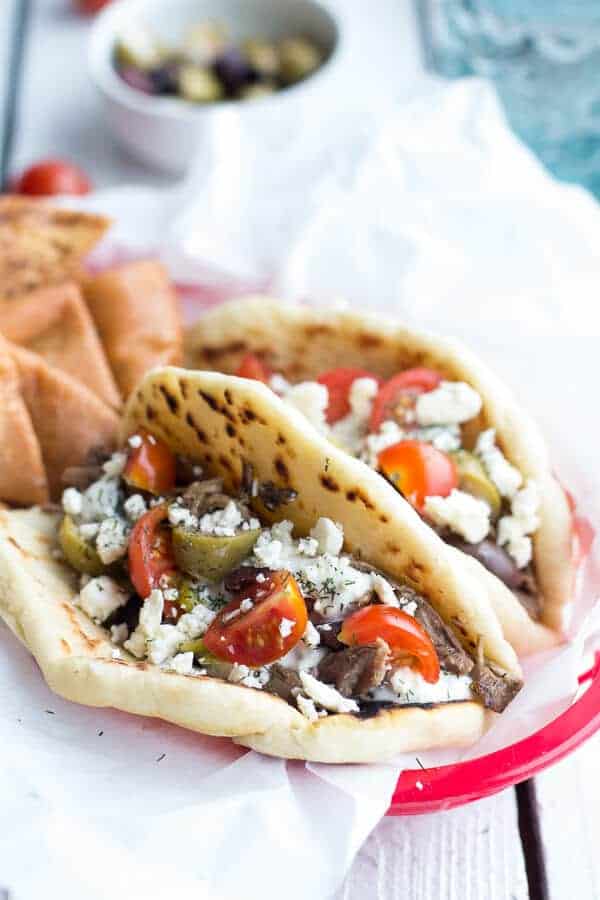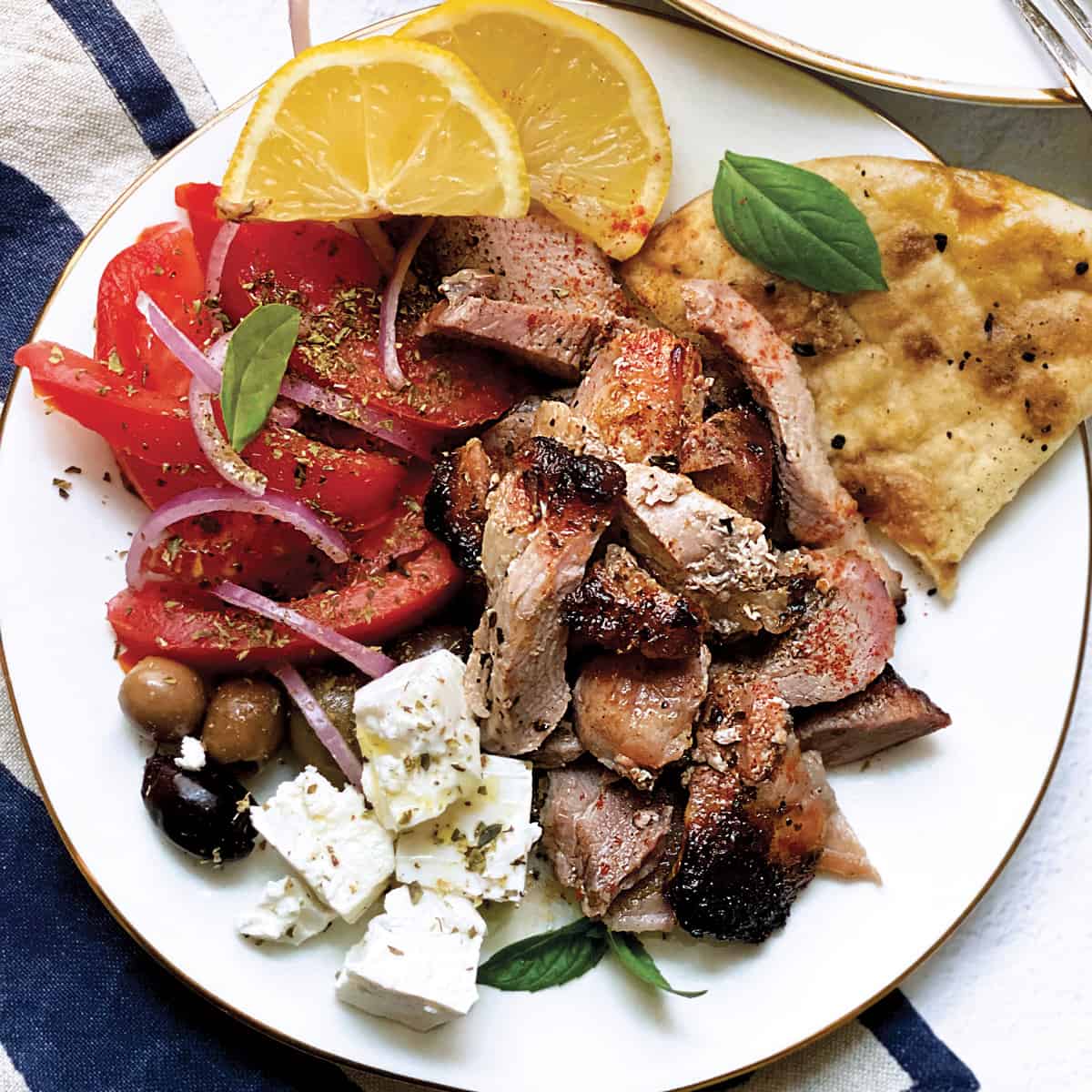Traditional Greek Gyro Recipe: Authentic and Delicious!
Who doesn’t love a flavorful Greek gyro? This traditional dish is a favorite around the world.
The mix of tender meat, fresh veggies, and creamy tzatziki sauce makes it irresistible. Greek gyros are a perfect combination of taste and simplicity. They capture the essence of Greek cuisine with every bite. In this blog post, you’ll learn how to make a traditional Greek gyro at home.
We’ll guide you step-by-step through the process, so you can enjoy this delicious meal anytime. Whether you’re a seasoned cook or a beginner, our recipe is easy to follow. Get ready to impress your family and friends with an authentic taste of Greece!
Introduction To Greek Gyro
Greek cuisine is a treasure trove of flavors. The Greek Gyro is one of its most beloved dishes. Imagine succulent meat, fresh vegetables, and tangy sauces wrapped in soft pita bread. This dish is a culinary journey in every bite. Let’s delve into the fascinating world of Greek Gyros.
Origins Of The Gyro
The word “gyro” means “turn” in Greek. This name reflects the cooking method. Traditionally, gyro meat is cooked on a vertical rotisserie. The concept of spit-roasting meat dates back to ancient times. Over the centuries, this method evolved into the modern gyro.
Gyros became popular in Greece in the 1920s. Immigrants from Turkey brought the idea. They adapted the Turkish doner kebab to create the gyro. Today, gyros are a staple in Greek cuisine. They are enjoyed by locals and tourists alike.
Cultural Significance
Gyros hold a special place in Greek culture. They are more than just food. Gyros represent tradition, community, and hospitality. They are often enjoyed during social gatherings. Street vendors selling gyros are a common sight in Greek cities. This makes gyros accessible and loved by many.
Gyros also symbolize Greek ingenuity. They showcase how simple ingredients can create a delicious dish. The combination of meat, vegetables, and pita is a testament to Greek culinary creativity. Every gyro tells a story of history and culture. It is a flavorful reminder of Greece’s rich heritage.
Essential Ingredients
The magic of a traditional Greek gyro lies in its essential ingredients. Each component plays a crucial role in creating the authentic taste. In this section, we will explore the key ingredients that make a Greek gyro special. From the meat selection to the spices and herbs, every detail matters.
Meat Selection
The choice of meat is the heart of a Greek gyro. Typically, lamb or pork is used, but chicken can also be a great option. The meat should be tender and flavorful. It is usually marinated to enhance its taste. This step ensures that every bite is juicy and delicious. Choose high-quality meat for the best results.
Spices And Herbs
Spices and herbs are vital for the gyro’s distinct flavor. Common spices include oregano, thyme, and garlic. Fresh herbs like parsley add a vibrant touch. The marinade often contains olive oil and lemon juice. These ingredients give the gyro its unique Mediterranean taste. Don’t forget a pinch of salt and pepper to balance the flavors. Proper seasoning is key to achieving an authentic gyro.
Preparing The Meat
Preparing the meat is a crucial step in making a traditional Greek gyro. The right techniques ensure the meat is flavorful and tender. Let’s explore how to marinate and cook the meat to perfection.
Marinating Techniques
Marinating the meat is essential for a delicious gyro. Start by choosing your meat. Lamb, chicken, or pork works best. Cut the meat into thin slices. This allows the marinade to soak in better. Use a mix of olive oil, lemon juice, garlic, oregano, and salt. These ingredients create a classic Greek flavor. Combine the meat and marinade in a bowl. Cover and refrigerate for at least two hours. For best results, marinate overnight.
Cooking Methods
Once the meat is marinated, it’s time to cook. Traditional gyros are cooked on a vertical rotisserie. Most home cooks don’t have this equipment. Don’t worry, there are other ways. You can use a grill or a pan. For grilling, preheat your grill to medium-high heat. Place the meat on the grill. Cook for about 4-5 minutes on each side. If using a pan, heat some oil over medium-high heat. Cook the meat in batches. Avoid overcrowding the pan. Each piece should be golden brown and cooked through.
Making The Tzatziki Sauce
The secret to a delicious Greek Gyro lies in its components, and the tzatziki sauce is one of the key elements. This creamy, garlicky yogurt sauce adds a refreshing flavor that complements the savory meat and fresh vegetables. Let’s dive into how to make this delightful sauce at home.
Ingredients Needed
- 1 cup Greek yogurt
- 1 cucumber, grated
- 2 cloves garlic, minced
- 1 tablespoon olive oil
- 1 tablespoon fresh dill, chopped
- 1 tablespoon lemon juice
- Salt to taste
Step-by-step Preparation
- Prepare the cucumber: Peel and grate the cucumber. Squeeze out the excess water using a clean cloth or paper towel.
- Mix the ingredients: In a bowl, combine the Greek yogurt, grated cucumber, minced garlic, olive oil, chopped dill, and lemon juice.
- Season: Add salt to taste. Stir well to combine all the ingredients.
- Chill: Cover and refrigerate the sauce for at least 1 hour before serving. This allows the flavors to meld together.
This simple yet flavorful tzatziki sauce will elevate your Greek Gyro, adding a creamy and refreshing touch to every bite. Enjoy!
Assembling The Gyro
Creating a traditional Greek gyro is an art. The key to a perfect gyro lies in how you assemble it. Each step ensures the flavors blend beautifully. Let’s dive into the process.
Pita Bread Preparation
Start with fresh, soft pita bread. Warm it slightly on a pan or grill. This makes it pliable and easier to fold. Avoid overcooking. You want it warm, not crispy.
Once warmed, place the pita on a clean surface. This will be your base for the gyro. Ready to layer the delicious fillings.
Layering The Ingredients
First, spread a generous amount of tzatziki sauce on the pita. This creamy sauce adds a tangy flavor. Next, add slices of juicy, seasoned meat. Traditional gyros use lamb, but chicken or pork works too.
Top the meat with fresh vegetables. Sliced tomatoes, onions, and cucumbers are classic choices. For a burst of flavor, sprinkle some crumbled feta cheese. Finally, finish with a few sprigs of fresh dill.
Once all ingredients are layered, carefully fold the pita. Wrap it in parchment paper or foil. This helps keep the gyro intact. Ready to serve and enjoy!

Credit: www.halfbakedharvest.com
Serving Suggestions
The Traditional Greek Gyro is a versatile dish. It pairs well with many sides and can be served in various ways. Here are some ideas to elevate your gyro experience.
Traditional Sides
For an authentic Greek meal, consider these classic sides:
- Tzatziki Sauce: A creamy yogurt and cucumber sauce. Perfect for dipping.
- Greek Salad: Fresh tomatoes, cucumbers, olives, and feta cheese.
- Pita Bread: Warm, soft, and ideal for wrapping your gyro.
- Fried Potatoes: Crispy on the outside, soft on the inside.
Modern Twists
For a contemporary take, try these unique options:
- Quinoa Salad: A healthy and modern alternative to the traditional Greek salad.
- Sweet Potato Fries: A healthier yet delicious side with a sweet twist.
- Avocado Slices: Adds a creamy texture and modern flavor.
- Hummus: A great dip made from chickpeas. Rich and flavorful.
| Traditional Sides | Modern Twists |
|---|---|
| Tzatziki Sauce | Quinoa Salad |
| Greek Salad | Sweet Potato Fries |
| Pita Bread | Avocado Slices |
| Fried Potatoes | Hummus |
These serving suggestions will make your Greek Gyro meal exciting and delicious. Whether you prefer traditional sides or modern twists, there is something for everyone to enjoy.
Tips For Authentic Flavor
Creating an authentic Greek gyro at home can be a rewarding experience. The key to achieving that traditional flavor lies in the details. Follow these tips to ensure your homemade gyro tastes just like the ones from Greece.
Common Mistakes
Avoid using pre-packaged spice mixes. They often lack the depth of flavor found in traditional recipes. Instead, use fresh herbs and spices. Another common mistake is overcooking the meat. This can make it dry and tough. For the best results, cook the meat slowly on a rotisserie.
Many people use the wrong type of yogurt for tzatziki sauce. Greek yogurt is essential. It has the right consistency and tanginess. Using regular yogurt can make your sauce runny and less flavorful.
Expert Advice
Marinate the meat for at least 2 hours. This allows the flavors to penetrate deeply. Use a mix of olive oil, lemon juice, garlic, oregano, and thyme. These ingredients are staples in Greek cooking.
For an authentic taste, use a combination of lamb and beef. This blend creates a rich and savory flavor. If lamb is hard to find, beef alone will also work.
Serve your gyro with fresh pita bread. Warm it slightly before serving. This enhances the overall experience. Don’t forget to add a generous amount of tzatziki sauce, fresh tomatoes, onions, and lettuce.:max_bytes(150000):strip_icc()/1910259-c95245e555554b9d815279f69bf6198a.jpg)
Credit: www.allrecipes.com
Gyro Variations
Gyros are a beloved Greek dish known for their savory taste and versatility. Originating from Greece, these delicious wraps have spread worldwide. Each region adds its unique twist, resulting in delightful variations. Let’s explore the different ways you can enjoy a gyro.
Regional Differences
Greek gyros often feature pork or chicken, marinated with herbs and spices. In Athens, you might find gyros served with fries inside the pita. The island of Crete is known for using lamb in their gyros, offering a distinct flavor. In Thessaloniki, gyros are typically spicier, with more garlic and paprika.
Outside of Greece, regional variations continue to evolve. In the United States, beef and lamb mixtures are popular. Middle Eastern countries prefer using beef or lamb, seasoned with their local spices. Each variation offers a unique taste experience, reflecting the local culture and ingredients.
Vegetarian Options
Vegetarian gyros are becoming more popular. They offer a delicious alternative for non-meat eaters. Many recipes use grilled vegetables like zucchini, eggplant, and bell peppers. These are often seasoned with the same spices used in traditional gyros.
Another popular option is using falafel. These chickpea patties provide a hearty and flavorful filling. Tofu or tempeh can also be used, marinated in traditional gyro spices. These options ensure that everyone can enjoy the delicious taste of a gyro, regardless of dietary preferences.
Credit: myriadrecipes.com
Frequently Asked Questions
What Is A Traditional Greek Gyro?
A traditional Greek gyro is a popular street food. It consists of meat, usually pork or chicken, wrapped in pita bread. It’s garnished with tomatoes, onions, and tzatziki sauce.
How Do You Make Gyro Meat At Home?
To make gyro meat, marinate slices of pork or chicken. Use olive oil, lemon juice, garlic, and herbs. Cook on a vertical rotisserie or grill.
What Toppings Go On A Greek Gyro?
Greek gyros are typically topped with fresh tomatoes, onions, and tzatziki sauce. Some variations may include lettuce, fries, or feta cheese.
Can You Make Gyros With Different Meats?
Yes, gyros can be made with various meats. Common options include pork, chicken, lamb, and beef. Each offers a unique flavor.
Conclusion
Enjoy making your own traditional Greek gyro at home. The flavors are rich and authentic. Perfect for family meals or gatherings. Remember, fresh ingredients make all the difference. Try this recipe and savor a taste of Greece. Cooking at home can be fun and rewarding.
Share your gyro with loved ones. They will appreciate the effort and love. Happy cooking!





